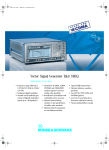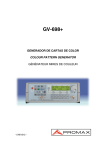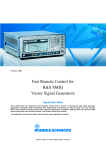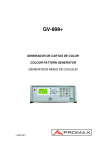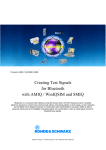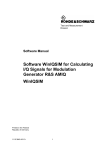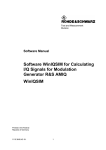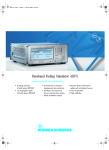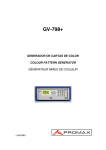Download Vector Signal Generator SMIQ
Transcript
Vector Signal Generator SMIQ Digital signals of your choice With compliments Helmut Singer Elektronik www.helmut-singer.de [email protected] fon +49 241 155 315 fax +49 241 152 066 Feldchen 16-24 D-52070 Aachen Germany Photo 43304-3 Brief description The B series of Signal Generator Family SMIQ for analog and digital modulation from Rohde&Schwarz is offering solutions for today and tomorrow. This series particularly takes into account future developments in the field of 3rd-generation digital mobile radio. The SMIQ family comprises four models which differ in their upper frequency limits. These feature a hitherto unrivalled versatility regarding signal generation and signal quality and are therefore ideal for use in development and type-approval testing. With their outstanding price/performance ratio, these signal generators are also economically attractive for applications in production. The wide frequency range from 300 kHz to 6.4 GHz covers all main radio bands including their IF ranges. The high-grade I/Q modulator fitted as standard ensures minimum error vector magnitude and high intermodulation suppression. Using modern digital signal processor (DSP) technology, the versatile concept allows the generation of highprecision digital modulation signals with high bit rates without any limitations on modulation modes or standards. In addition to digital modulation, the signal generators provide the full range of analog modulation modes as well as simultaneous modulation capability. Main features • Frequency range 300 kHz to 2.2 GHz/ 3.3 GHz/4.4 GHz/6.4 GHz • Analog and digital modulation • Versatile and broadband generation of digitally modulated signals up to 18 Msymbol/s • Generation of TDMA, CDMA, WCDMA and CDMA2000 standard signals to all main mobile radio standards • Broadband I/Q modulator with outstanding vector accuracy • Optional internal fading simulator to test specifications of mobile radio standards • Optional internal noise generator and distortion simulator • Optional BER measurement • Optional arbitrary waveform generator • Low ACP for IS-95 CDMA and W-CDMA (option) • Low cost of ownership due to threeyear calibration intervals • Future-oriented platform concept • Unrivalled price/performance ratio Characteristics Digital modulation Any digital modulation modes (with option SMIQB20) • Free choice of modulation mode from ASK through to 256QAM • Any kind of baseband filtering with variable filter parameters • Symbol rate adjustable up to 18 Msymbol/s • Realtime coding of internal and external data • Internal PRBS generators Convenient burst generation for TDMA standards (with option SMIQB20/ SMIQB11) • TDMA mobile radio standards provided as standard GSM, GSM-EDGE, DECT, NADC (IS-54C/IS-136), PDC, PHS • Versatile external synchronization capabilities • Realtime processing of external and internal data • Generation of TDMA frames with versatile timeslot configuration • Continuous PRBS sequences • Optimization of burst shaping to reduce spectra due to switching • Realtime processing with external data for BER tests • Slot-by-slot modulation change for TDMA • Fast setting time for frequency (<3 ms) and level (<2.5 ms)1 ) • Frequency hopping (500 μs) • High spectral purity (typ. –130 dBc Vector Signal Generator SMIQ Overview of options FM/ϕM Modulator Data Generator (15 Mbit RAM) Memory Extension, 32 Mbit Fading Simulator (6 paths) 2nd Fading Simulator (6 paths) Noise Generator and Distortion Simulator Digital Modulation Coder BER measurement Digital Standard IS-95 CDMA Digital Standard W-CDMA (NTT DoCoMo1.0, ARIB 0.0) Digital Standard W-CDMA according to 3GPP (FDD) Low ACP for IS-95 CDMA and W-CDMA Extended Functions for W-CDMA 3GPP Arbitrary Waveform Generator Digital Standard IS-95 CDMA (with ARB SMIQB60) Digital Standard CDMA2000 (with ARB SMIQB60) SMIQB11 2 ) SMIQB12 SMIQB14 SMIQB15 SMIQB17 SMIQB20 SMIQB21 SMIQB42 3 ) SMIQB43 3) SMIQB45 3) SMIQB47 SMIQB48 SMIQB60 SMIQK11 SMIQK12 TDMA To standard Non-standard CDMA IS-95 To standard W-CDMA To standard CDMA2000 To standard Fading SM-B5 Application1 ) Reference Oscillator OCXO (1 Hz) at 1 GHz and 20 kHz carrier off- SM-B1 12 ❍ ❍ ❍ ● ● ❍ ❍ ❍ ❍ ❍ ● ● ❍ ❍ ❍ ● ❍ ❍ ❍ ● ❍ ❍ ❍ ❍ ● ❍ ❍ ❍ ● ❍ ❍ ● ❍ ❍ ❍ ● ● ❍ set) ● ● ● ● ❍ ❍ ● ● Vector modulation ❍ ❍ ❍ ● ❍ ❍ ❍ ❍ ❍ ❍ ❍ ❍ ❍ ❍ ❍ ❍ ❍ ❍ ❍ ❍ ❍ ❍ ❍ ❍ Analog modulation (AM, FM, ϕM) ❍ Fast setting time 1) SMIQ02B/03B (SMIQ04B/06B) can be equipped with up to three (two) of the following options: SM-B5, SMIQB14, SMIQB15 or SMIQB17 2) Option SMIQB20 required ● = required 3) Options SMIQB20 and SMIQB11 required ❍ = optional Analog modulation • Broadband AM with up to 30 MHz modulation frequency • I/Q modulation with 30 MHz modulation bandwidth (3 dB), 60 MHz RF bandwidth • Unprecedented vector accuracy and high intermodulation suppression • Amplitude modulation • Pulse modulation • Optional frequency and phase modulation (SM-B5) RF characteristics • Wide output frequency range from 300 kHz to 6.4 GHz • High (up to 16 dBm) and precise output level (<0.5 dB) • Calibrated RF level in range from –140 dBm to –5 dBm • RF, AF and level sweep (user-programmable) Special options Fading simulation (options SMIQB14 and SMIQB15) • Fading of internal or external I/Q signals conforming to mobile radio standards • 6-path simulation can be enhanced to 12-path simulation (2-channel fading also possible with second vector signal generator) • Rayleigh, Rice and lognormal fading profiles can be selected independently for each path • Selectable path attenuation and delay • Simulation of high speeds • Preprogrammed fading profiles for mobile radio standards GSM, NADC, IS-95 CDMA and TETRA • Frequency range of basic unit can be fully utilized Noise generator and distortion simulator (option SMIQB17) • Simulation of amplitude and phase distortion (AM/AM and AM/ϕM characteristics) • Distortion characteristics programmable from up to 30 input values • Superimposed noise signals (AWGN) • C/N ratio variable with high resolution over a wide range • Broad noise bandwidth (10 kHz to 10 MHz) 1) without switching the mechanical attenuators. Vector Signal Generator SMIQ Bit error rate measurements (option SMIQB21) • Up to 30 MHz clock rate W-CDMA für 3GPP/FDD (Option SMIQB45) Software option SMIQB45 supports the generation of downlink and uplink signals in line with the 3GPP standard (FDD mode). As the standardization process is not yet completed, the functionality of this option will continuously be adapted to the relevant standard modifications and expansions (for functionality see specifications). Low ACP for IS-95 CDMA and W-CDMA (option SMIQB47) • Specially designed for 1.2288 Mcps, 4.096 Mcps and 8.192 Mcps as well as 3.840 Mcps according to 3GPP • Can be used with internal (option SMIQB42/43/45/48) or external CDMA/W-CDMA signals • Typical W-CDMA adjacent-channel power ratio (5 MHz offset, 3.84 Mcps): –67 dBc (1 DPCH) • Typical IS-95 CDMA adjacent-channel power ratio (885 kHz offset): –78 dBc (9 code channels) Enhanced functions for W-CDMA 3GPP (FDD) digital standard (Option SMIQB48) This option expands the functionality of option SMIQB45 W-CDMA 3GPP. It allows the generation of up to four enhanced channels that can be combined with the standard channels. • Very long signal sequences and continuous PRBS sequences (eg PN9) often required for BER measurements can be implemented for the channel under test • Use of externally precoded data or the generation of long power control profiles for the DUT • Testing the closed-loop power control function of a mobile station • Receiver and performance tests to TS 25.101, TS 25.104, TS25.14. and TS25.944 • Realistic simulation of W-CDMA scenarios • Creation and insertion of bit errors into the data of enhanced channels • Insertion of block errors (BLERs) into the channel-coded data • Generation of W-CDMA signals of up to 2 minutes repetition rate Enhanced fading functions for W-CDMA 3GPP (Option SMIQB49) Option SMIQB49 extends the functionality of fading options SMIQB14/B15 to include W-CDMA 3GPP channel simulation. It adds three new modes to the fading simulator so that all scenarios defined in 3GPP Release 99 can be simulated: • In fine delay mode, fading simulator resolution is increased to 1 ns with up to four paths being available • In moving delay mode, two paths are simulated: for one path the delay remains constant, whereas for the other path the delay varies continuously • In birth-death mode, there are two paths changing delay in steps in accordance with the 3GPP channel model Digital standard IS-95 (Options SMIQK11 and SMIQB60 (ARB)) In addition to generating IS-95 signals with option SMIQB42, SMIQ in conjunction with SMIQB60 simulates CDMA signals to the North-American standard IS-95A. Option SMIQK11 enables IS-95 functionality under WinIQSIM™. • Up to eight complete base stations comprising 64 code channels each are available in forward link and up to 16 mobile stations in reverse link • Channel power can be set independently for all code channels • Adjacent-channel power can be calculated for 1. and 2. adjacent channel and output as a spectral display • CCDF trace can be displayed Digital standard CDMA2000 (Options SMIQK12 and SMIQB60 (ARB)) CDMA signals to the North-American standard IS-2000 can be simulated by means of software option SMIQK12 in conjunction with Arbitrary Waveform Generator SMIQB60. Option SMIQK12 enables CDMA2000 functionality under WinIQSIM™. The modes 1X direct spread, 3X direct spread and 3X multicarrier (forward link only) are available. In forward link four base stations of max. 91 code channels can be set, in reverse link four mobile stations of max. 13 code channels each. Arbitrary Waveform Generator SMIQB60 To further enhance the versatility of the modulation coder, a dual-channel arbitrary waveform generator (ARB) with a maximum clock rate of 40 MHz is available as an option. It can store up to 512 ksamples of externally computed I/Q values. The supplied WinIQSIM™ software allows the calculation of arbitrary modulation signals, for example COFDM, multicarrier and noise, and downloading them 12 With compliments Vector Signal Generator SMIQ Helmut Singer Elektronik www.helmut-singer.de [email protected] fon +49 241 155 315 fax +49 241 152 066 Feldchen 16-24 D-52070 Aachen Germany into SMIQ. Together with a convenient data editor, WinIQSIM™ can calculate any kind of TDMA frame configuration, simulate impairments by superimposed interference signals, etc. Applications • Type-approval testing of digital base and mobile stations • Base-station transmitter test • Sensitivity measurements on digital receivers Specifications in brief Frequency Range SMIQ02B SMIQ03B SMIQ04B SMIQ06B Resolution Reference frequency Aging (after 30 days operation) Temperature effect (0°C to 50°C) Level Range SMIQ02B/03B SMIQ04B/06B Overranging without guarantee of specs Resolution Total level uncertainty >−127 dBm 2) 3) f ≤2 GHz f >2 GHz to 4 GHz f >4 GHz to 6 GHz f >6 GHz Frequency response at 0 dBm2) 3) f ≤3.3 GHz f >3.3 GHz Spectral purity2) Spurious Harmonics at levels ≤10 dBm (SMIQ02B/03B) Harmonics at levels ≤7 dBm (SMIQ04B/06B) Broadband noise, carrier offset >5 MHz f >20 MHz to 450 MHz f >450 MHz to 3040 MHz f >3040 MHz to 3300 MHz f >3300 MHz to 6400 MHz Broadband noise, vector modulation, (f >20 MHz) carrier offset >5 MHz SSB phase noise, carrier offset 20 MHz, 1 Hz bandwidth f = 20 MHz to 450 MHz f = 1 GHz f = 2 GHz f = 3 GHz f = 6 GHz Sweep RF sweep, AF sweep Modes • Selectivity measurements on digital receivers • Testing of equalizers • Tolerance tests on digital systems • Components tests • Development of new digital communication systems Modulation 300 kHz to 2.2 GHz 300 kHz to 3.3 GHz 300 kHz to 4.4 GHz 300 kHz to 6.4 GHz 0.1 Hz Standard Option SM-B1 1 x 10–6/year <1 x 10–9/day –6 x 2 10 <5 x 10–8 −144 dBm to +13 dBm (PEP)1) −144 dBm to +10 dBm (PEP)1) up to16 dBm 0.1 dB or 0.01 dB <±1 dB <±1.5 dB <±2 dB <±2.5 dB (typ. <±0.5 dB) (typ. <±0.9 dB) (typ. <±1.2 dB) <1 dB <±1.5 dB (typ. <0.3 dB) (typ. <±0.5 dB) Internal modulation generator Frequency range Frequency error Open-circuit voltage at LF socket Vector modulation Level accuracy with vector modulation, additional error with ALC OFF, relative to CW Modulation inputs I and Q Input voltage for full-scale input Envelope control Amplitude modulation2) Modulation depth Broadband amplitude modulation Input voltage for 100% AM Pulse modulation On/off ratio Rise/fall time(10/90%) Pulse repetition frequency Frequency modulation Max. deviation Phase modulation <–30 dBc <–30 dBc Max. deviation Digital modulation CW <–136 dBc <–138 dBc <−136 dBc <−132 dBc (typ.−142 dBc) (typ.−144 dBc) (typ.−142 dBc) (typ.−138 dBc) <−131 dBc (typ. −137 dBc) CW Vector modulation (dig. Mod.) <–119 dBc <–123 dBc <–120 dBc <–116 dBc <–110 dBc <–116 dBc <–126 dBc <−120 dBc <−116 dBc <–110 dBc digital sweep in discrete steps automatic, single shot, manual or external trigger, linear or logarithmic 0.1 Hz to 1 MHz <1 x 10−4 + 0.012 Hz 1 mV to 4 V peak <0.3 dB I 2 + Q 2 = 0.5 V (1 V EMK with 50-Ω Source) RF level can be controlled with an analog voltage of 0 V to 1 V via the POWER RAMP input internal, external AC/DC 0% to 100% external DC 0.25 V peak external >80 dB typ. 30 ns 0 Hz to 1 MHz Option SM-B5 int., external AC/DC, two-tone with two modulation channels FM1 and FM2 0.5/1/2/4 MHz depending on frequency Option SM-B5 int., external AC/DC, two-tone with two modulation channels ϕM1 and ϕM2 5/10/20/40 rad depend. on frequency Option SMIQB20 internal, external, serial, ext. parallel Predefined modulation settings APCO C4FM, APCO CQPSK, CDPD, CT2, DECT, GSM, IRIDIUM, NADC, PDC, PHS, TETRA, TFTS, PWT, ICO BPSK, ICO GMSK, ICO QPSK, GSM EDGE, CDMA IS-95, W-CDMA, QPSK Internal PRBS selectable lengths: 29–1, 215–1, 216–1, 220–1, 221–1 and 223–1 Envelope control internal or external Range of function 1 ksymbol/s to 2.5 Msymbol/s Modulation modes ASK, FSK, GMSK, PSK, QAM ASK, symbol rate 100 symbol/s to 18 Msymbol/s 1) FSK, modulation modes 2FSK, 4FSK, 4FSK APCO, GFSK 100 bit/s to 7.5 Mbit/s1) GMSK, bit rate PSK, modulation modes BPSK, QPSK, OQPSK, QPSK (IS-95), OQPSK (IS-95), QPSK (ICO), QPSK (INMARSAT), π/4DQPSK, π/4QPSK, 8PSK, 8PSK EDGE QAM, modulation modes 16QAM, 32QAM, 64QAM, 256QAM 12 Speed range Data generator Option SMIQB11 Programmable data memory for modulation data, envelope-control and trigger signals. The data generator can be operated only in conjunction with the optional modulation coder Max. symbol rate 8.5 Msymbol/s Operating modes automatically repeating, single shot, manually or externally triggered Memory extension Option SMIQB12 The data generator memory can be extended to max. 79 Mbit by fitting up to two options SMIQB12. Memory capacity 32 Mbit Digital standards GSM / EDGE Frequency Modulation DECT Frequency Modulation NADC Frequency Modulation PDC Frequency Modulation PHS Frequency Modulation Options SMIQB20 and SMIQB11 according GSM standard 880 to 960 MHz/1710 to 2000 MHz GMSK or 8PSK EDGE (8PSK with 3π/8 Rotation) according ETS300175-2 and ETS300176-1 1880 MHz to 1900 MHz GFSK (Standard), π/4 DQPSK according IS-54 and IS-136 824 to 894 MHz/1850 to 2000 MHz π/4 DQPSK according RCR STD-27 810 to 826 MHz/940 to 956MHz 1429 to 1453 MHz/1477 to 1501 MHz π/4 DQPSK according RCR STD-28 1895.0 MHz to 1918.1 MHz π/4 DQPSK Digital standard IS-95 CDMA Option SMIQB42 According TIA standard IS-95A and J-STD-008 Frequency 824 to 894 MHz/1850 to 2000 MHz Modulation QPSK, OQPSK Digital standard W-CDMA Frequency Modulation Option SMIQB43 2) 1800 MHz to 2200 MHz QPSK, OQPSK Digital standard W-CDMA 3GPP (FDD) Option SMIQB45 3) according 3GPP standard 3.4.0 (FDD) 3GPP (FDD) Version optional 3.4.0, according technical specifications 3GPP TS25.211 and TS25.213 Frequency 1800 MHz to 2200 MHz Simultanous modulation Any combination is possible with the following exceptions: – Simultaneous FM and ϕM – Simultaneous digital modulation and vector modulation Pulse modulation cannot be used together with level attenuation function LEV ATT (option SMIQB20) Options for special applications Fading simulation paths and channels with option SMIQB14 with options SMIQB14 and -B15 Path attenuation Options SMIQB14, SMIQB15 6 paths, 1 channel 12 paths, 1 channel or 6 + 6 paths, 2 channels with second SMIQ through simple retrofit 1) PEP = peak envelope power. 2) Data apply to RF ≥5 MHz unless specified otherwise and for ATTENUATOR MODE NORMAL function. 3) Additional error with ALC OFF <0.3 dB. 0 dB to 50 dB 0 μs to 1600 μs 0.1 Hz to 1600 Hz Path delay Doppler shift Vector Signal Generator SMIQ v 9m 0, 03x10 ----2s = -------------------------------min f RF 9m 479x10 ----2sv max = ---------------------------f RF Rayleigh fading, pseudo noise intervall Rice fading Power ratio4) Frequency ratio Lognormal fading, Suzuki fading Standard deviation Correlation >372 h −30 dB to +30 dB −1 to +1 0 dB to 12 dB paths 1 to 6 with paths 7 to 12 Enhanced fading functions for Option SMIQB49 W-CDMA 3GPP The following data deviate from the specifications for SMIQB14/SMIQB15 Fine delay mode Number of paths 2 (with SMIQB14), 4 (with SMIQB14 + SMIQB15) Rayleigh, pure Doppler Profiles Delay, resolution 25 ns to 1637 μs, 1 ns Moving delay mode 2 Number of paths 0 to 1000 μs (in 50 ns steps) Delay, path 1 delay path 1 + delay variation (peak-peak) Delay, path 2 x sin ( 2pt /variation period) 150 ns to 50 μs Delay variation (peak-peak) 10 s to 500 s Variation period <1 ns Delay step size Birth-death mode Number of paths 2 Profiles pure Doppler Delay 5 μs to 1000 μs Delay range 5 μs to +5 μs (not variable) Delay grid 1 μs (not variable) Hopping dwell 100 ms to 5 s Noise and distortion simulation Distortion simulator Distortion characteristic Option SMIQB17 AM/AM and AM/ϕM distortion of modulation signal each characteristic programmable by entering up to 30 input values via IEEE/ IEC bus or by entering up to five polynomial coefficients Noise generator (AWGN) Distribution density Crest-Faktor C/N Gaussian, statistically indep. for I and Q 14 dB −30 dB to 30 dB Bit error rate measurement Option SMIQB21 Pseudo-random bit sequences (PRBS) 29-1, 211-1, 215-1, 216-1, 220-1, 221-1, 223-1 Measurement time selectable through maximum number of data bits or bit errors (max. 231 bits each), continuous measurement Measurement result BER in ppm, % or decade values (if selected number of data bits or bit errors is attained) status displays: not synchronized, no clock, no data Improved adjacent-channel power Option SMIQB47 ratio for W-CDMA and CDMA IS-95 Selectable baseband filters to improve ACP values (values see at Digital Standards CDMA/W-CDMA) Enhanced functions for digital standard W-CDMA 3GPP (FDD) 3GPP (FDD) version Option SMIQB48 3.4.0 to 3GPP technical specifications TS25.101, TS25.104, TS25.141, TS25.211 and TS25.213 Vector Signal Generator SMIQ Enhanced Channels Channels of W-CDMA system in SMIQ that offer enhanced functionality compared with standard channels of option SMIQB45. Can be used in downlink for max. four DPCHs and in uplink for one DPCCH and max. three DPDCHs. All DPCHs or DPDCHs have the same symbol rate. Enhanced functions at a glance: • Sequences of up to 1042 frames • Data lists for data fields and TPC field • External power control • Channel coding • Bit error insertion • Block error insertion Simulation of realistic noise scenarios • Orthogonal channel noise simulation (OCNS) • Additional mobile stations Arbitrary waveform generator Waveform memory, interpolation Output memory Length of waveform Resolution Downloading time for 512k I/Q samples Nonvolatile memory Number of blocks Option SMIQB60 1 to 524216 in steps of one sample 12 bit 4s 22 (one waveform occupies at least one block) 24 from firmware version 5.30 65527 0.375 x clock rate Block size Interpolation Interpolation bandwidth (-0.1dB) Repetitive spectra suppression through analog filter >70 dB Clock generation Clock rate Resolution Clock mode Signal output, channels Output level (EMF, peak) Normal mode Manual mode Level difference between channels DC offset Frequency response Magnitude up to 12 MHz/10 MHz Group delay up to 10 MHz I/Q imbalance Magnitude up to 10 MHz Group delay up to 10 MHz SFDR (sinewave 1 MHz, clock 4 MHz, measurement range up to 12 MHz) Trigger modes Trigger source Trigger outputs Delay On time Off time Level 1 kHz to 40 MHz 0.1 Hz internal or external 2 (I and Q) SQRT(I2 + Q2) = 1 V, 50 Ω –6 dB to 0 dB referred to 1 V, setting range up to +3 dB <0.2% at 1 kHz 1) <–54 dB in normal mode 1) <1 dB/typ. 0.1 dB typ. 1 ns typ. 0.05 dB typ. 0.5 ns >60 dB auto, retrig, armed auto, armed retrig internal or external 2 0 to 524216 samples 1 to 524215 samples 1 to 524215 samples TTL 1) Spectral components exceeding max. IQ bandwidth will be suppressed. 2) Cannot be fitted together with Digital Standard W-CDMA 3GPP (option SMIQB45). 3) Cannot be fitted together with Digital Standard W-CDMA NTT DoCoMo (option SMIQB43). 4) Ratio of discrete and distributed component. 5) Contrast of LCD lower at higher temperature. General data Memory for instrument settings 50 storable settings List Mode Frequency and level values can be stored in a list and set in an extremely short time; permissible level variation: 90 dB Max. number of channels 2000 Remote control IEC 625 (IEEE 488) Command set SCPI 1993.0 Power supply 90 V to 265 V (AC), 50 Hz to 400 Hz, autosetting to AC supply, max. 300 VA Dimensions (W x H x D) 435 mm x 192 mm x 460 mm Weight 25 kg when fully equipped Ordering information Vector Signal Generator 300 kHz to 2.2 GHz 300 kHz to 3.3 GHz 300 kHz to 4.4 GHz 300 kHz to 6.4 GHz SMIQ02B SMIQ03B SMIQ04B SMIQ06B Accessories supplied power cable, operating manual 1125.5555.02 1125.5555.03 1125.5555.04 1125.5555.06 Options Reference Oscillator OCXO SM-B1 1036.7599.02 FM/ϕM Modulator SM-B5 1036.8489.02 Data Generator SMIQB11 1085.4502.04 Memory Extension, 32 Mbit SMIQB12 1085.2800.04 Fading Simulator, 6 paths SMIQB14 1085.4002.02 Second Fading Simulator for 12 paths or 2 channels SMIQB15 1085.4402.02 Noise Generator and Distortion Simulator SMIQB17 1104.9000.02 RF and AF Rear Connectors SMIQB19 1085.2997.02 Modulation Coder SMIQB20 1125.5190.02 BER Measurement SMIQB21 1125.5490.02 Digital Standard IS-95 CDMA SMIQB42 1104.7936.02 Digital Standard W-CDMA acc. to NTT DoCoMo 1.0, SMIQB43 1104.8032.02 ARIB 0.0 standard Digital Standard W-CDMA according to 3GPP (FDD) SMIQB45 1104.8232.02 Low ACP for IS-95 CDMA and W-CDMA SMIQB47 1125.5090.02 Modification Kit for Low ACP (factory-fitted only) SMIQU47 1125.5149.02 Extended Functions for W-CDMA (3GPP) SMIQB48 1105.0587.02 Extended Fading Functions for W-CDMA (3GPP) SMIQB49 1105.1083.02 Arbitrary Waveform Generator incl. WinIQSIM™ SMIQB60 1136.4390.02 TETRA T1 Simulator SMIQ-K8 1136.4290.02 Digital Standard IS-95 CDMA (software for SMIQB60) SMIQK11 1105.0287.02 Digital Standard CDMA2000 (software for SMIQB60) SMIQK12 1105.0435.02 Dig. Standard W-CDMATDD mode (3GPP) (for option SMIQK13 1105.1231.02 SMIQB60) Digital Standard TD-SCDMA (software for SMIQB60) SMIQK14 1105.1338.02 OFDM Signal Generation, HIPER LAN/2 SMIQK15 1105.1531.02 Additional hint: SMIQ02B/03B (SMIQ04B/06B) can be equipped with up to three (two) of the following options: SM-B5, SMIQB14, SMIQB15, SMIQB17 Application software Generation of data and control lists Bluetooth signals for SMIQ User mappings and user filters for SMIQ SMIQ-K1 *) SMIQ-K5 *) User Mod *) *) available on www.rohde-schwarz.com Extras 19" Adapter Service Kit BNC Adapter for rear panel, D type connector PAR DATA 90° Power Splitter Trolley for Transit Case Transit Case Service Manual SMIQ Instrument upgrades SMIQ02B to SMIQ03B SMIQ03B to SMIQ04B SMIQ04B to SMIQ06B ZZA-94 SM-Z3 0396.4905.00 1085.2500.02 SMIQ-Z5 SMIQ-Z9 ZZK-1 ZZK-944 1104.8555.02 1104.9580.02 1014.0510.00 1013.9366.00 1085.2445.24 SMIQU03 SMIQU04 SMIQU06 1125.5855.03 1125.5855.04 1125.5855.06






